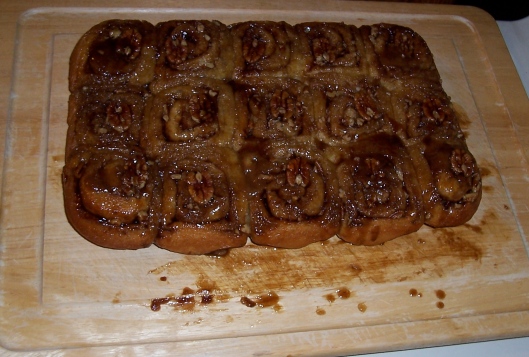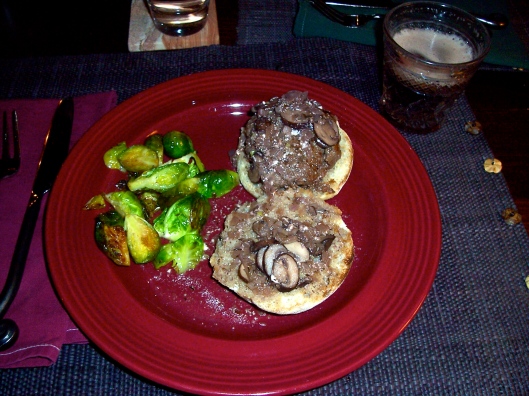Tags
agriculture, animals, beef, bobolinks, farming, food, mushroom wine-burgers, raw milk, recipes
Everything is connected to everything else: this is Barry Commoner’s so-called “first law of ecology.” It’s apparent at all levels of life, of course, if you’re only willing to look deep. And you only need to read a little Wendell Berry to see how rural communities used to function this way, with neighbors feeding each other and being fed, neighbors helping each other and being helped.
Luckily, there are still remnants of this interdependence in the town where I live. Not only in terms of local economies and keeping dollars in the community – I’m talking about how our land, our work, and our friends and neighbors are all connected.
An illustration: Last summer, Tim and I heard that our local dairy farmer (whom I will call Pete), from whom we buy raw, organic milk at a price far below what we’d pay in the store – and also at a price much higher than what he gets by selling it to the cooperative – was planning to mow our fields for hay in early July.*
I was upset when I heard about this plan, since the bobolinks were still nesting. Bobolinks and their decline are one of the ways rural life is not working out, at least for the birds. My spouse’s uncle was a dairy farmer before he retired, and says that, with his old mower, he’d see the bobolink nests as he was haying and go around them. But with the new mowers, you can’t see what’s nesting until it’s too late. So bobolink numbers have declined sharply since the new mowers went on the market. And while bobolinks are considered a beneficial bird in northern agriculture because they eat pests, they are considered a pest themselves by South American rice farmers, who shoot them. Finally, as more and more land shifts from pasture or hay fields to corn, the bobolinks and other grassland birds are finding their habitat shrinking. (This is an example of how small-scale, grass-fed meat and dairy, such as cows and goats, actually benefit the farm ecology.)
A Vermont dairy farmer can only address one of those issues, and that’s by haying during the bobolinks’ off-season. As Nadine Berrini, writing for the Vermont Land Trust, explains, “the Environmental Quality Incentives Program (EQIP) Grassland Bird Initiative offers eligible farmers $100 per acre to mow prior to June 2 and then not mow again for 65 days. The purpose of this program is to give grassland birds a chance to reestablish successful nests while allowing for an early cut of hay.” However, many farmers are not aware of this program, and even for those who do, it’s not always possible, because of weather issues, for farmers to hay that early or that late.
Still, I was distraught at the thought of my bobolink neighbors’ chicks being killed by the mower, so I raised the issue with my father-in-law, who took it to Pete. Pete agreed to hay only the lower fields, which were free of nesting birds. Later that week, I had the joy of seeing the young bobolinks fledge in the upper fields. Their parents still fluttered above my head, trying to distract me from their young, but the young were safe.
Over the holidays, to thank Pete for changing his schedule, Tim made him a pan of his amazing maple-frosted pecan sticky rolls, and I wrote a thank-you/Merry Christmas card.
Then, just a couple of weeks ago, when Tim was up at Pete’s barn drawing some milk, Pete thanked us for thanking him, by giving us a pound of freshly ground beef. He’d just slaughtered a young steer, and the beef was very lean, he said.
I was a little taken aback by this gift, because not only do Tim and I eat very little meat, but I haven’t cooked anything with ground beef since I was a teenager, and then only on the grill. But since we were getting together with my in-laws for dinner later that week, I decided to try making what my family (before half of them turned vegetarian) called Mushroom Wine-burgers.
4 servings.
Ingredients:
- 1 lb. grass-fed ground beef
- 1 teaspoon soy sauce or mushroom soy sauce
- 2 teaspoons tomato paste
- 1/2 teaspoon garlic powder
- 1/2 teaspoon pepper
- 1 egg, beaten (optional)
- 1/2 lb. to 1 lb. mushrooms (depending on how much you love mushrooms!)
- 4 Tablespoons butter
- 1 onion or shallot, minced
- 1/2 teaspoon dried thyme
- 1/2 cup red wine
- 1/2 cup beef or mushroom stock
- 1 teaspoon corn starch
- 1 Tablespoon water
- 1/2 cup sour cream or plain yoghurt
- 4 English muffins
Mix the beef with the soy sauce, tomato paste, garlic powder, and pepper. If using, add egg (the egg will help the burgers not fall apart on the plate or in the pan; however, since this is eaten with knife and fork, the egg is not necessary). Shape into four patties and refrigerate (stack between pieces of waxed paper so the burgers don’t stick together) for at least half an hour.
Add mushrooms to dry, heated skillet (the mushrooms will make their own liquid as they cook, and besides, this recipe already has enough butter in it). Sauté on medium about 5 minutes. Turn up heat to medium-high, and stir in butter, onions, and thyme. Cook a couple more minutes.
Add the wine to the pan. Cook, stirring, until the wine is reduced by half. Then do the same with the stock.
Mix the corn starch with the water, and add to the pan. Cook sauce until thickened. Add a spoonful of sauce to the sour cream, mix together, then add the sour cream mixture to the rest of the sauce – this will help it blend better. Remove the sauce from the skillet but keep it warmed in a covered bowl. Start toasting the English muffins.
Put patties in the skillet; cook on medium high for a couple of minutes. Turn the patties, cook another minute. Cover, and cook for another two minutes.
Serve each patty on one half of an English muffin, then ladle sauce over both halves of muffin. Serve with a side of green veggies.
*Current Use laws mean that my in-laws get a tax break for keeping part of their land in cultivation, if you can call growing grass “cultivation.” So my in-laws lease the land to Pete for a low price, and get 20 or so square bales to use for chicken and duck bedding. And Current Use means that more fields stay open, rather than filling in with woods, and that means more grassland ecosystems. It also means property values don’t go through the roof and drive out all the small family farms.



Great story about working with your neighbor and what a reward he got! Those rolls look amazing.
They are incredible. Decadent. But they’ve successfully weaned me off of King Arthur Flour’s sticky rolls. 🙂
Beautiful, Kellyann. Brought tears to my eyes, and reminded me of the conversation I had with my brother this fall, about just such interdependence. Another reason to live where you are. I’m digesting that. Thank you!
Oh, thanks, Kendra! By the way, I’d love to meet your brother sometime.